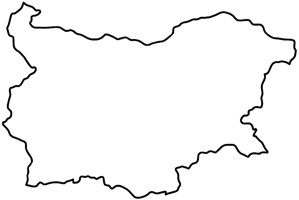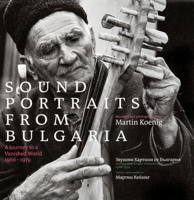
|
The Society of Folk Dance Historians (SFDH)
Bulgarian Village Music
[
Home |
About |
Encyclopedia | CLICK AN IMAGE TO ENLARGE |

|
There is a great concern in Bulgaria today that folk music must be preserved in the face of rapid social changes there.

 A time-honored tradition of the Bulgarians is the mourning for a relative, or a good friend who has passed on. For six months or more afterwards, a person in mourning will refrain from dancing, singing, or playing music. For example, when a child was accidentally killed in a village near Sofia, his mother, a very fine singer, vowed that she would never sing again. About the same time, a man living in the village of Bistrica, also not far from Sofia, was killed in an auto accident. He was the village archivist, and remembered all the songs, dances and rituals, and was a vital force in preserving the local folk customs. The singers, dancers, and musicians who came to his funeral performed with such emotion that folklorists who had also come to honor him, found it hard to accept the fact that, following the rites, there might well be no more music and dancing in that village until after a long mourning period. The villagers though, true to tradition, vowed to lay aside their instruments until the prescribed period of mourning had passed. At this point, the folklorists argued that the best way to honor Trajko Đurđiev would be to continue doing that which he so loved – so the village did not fall quiet, and the renewed music-making helped preserve this outstanding manifestation of Bulgarian folk culture.
A time-honored tradition of the Bulgarians is the mourning for a relative, or a good friend who has passed on. For six months or more afterwards, a person in mourning will refrain from dancing, singing, or playing music. For example, when a child was accidentally killed in a village near Sofia, his mother, a very fine singer, vowed that she would never sing again. About the same time, a man living in the village of Bistrica, also not far from Sofia, was killed in an auto accident. He was the village archivist, and remembered all the songs, dances and rituals, and was a vital force in preserving the local folk customs. The singers, dancers, and musicians who came to his funeral performed with such emotion that folklorists who had also come to honor him, found it hard to accept the fact that, following the rites, there might well be no more music and dancing in that village until after a long mourning period. The villagers though, true to tradition, vowed to lay aside their instruments until the prescribed period of mourning had passed. At this point, the folklorists argued that the best way to honor Trajko Đurđiev would be to continue doing that which he so loved – so the village did not fall quiet, and the renewed music-making helped preserve this outstanding manifestation of Bulgarian folk culture.
The vibrant richness of Bulgarian folk music would be astonishing, considering the country's small size, were it not for its location between Asia Minor and Western Europe. Cultural deposits have been left by many different peoples using Bulgaria as a corridor, or imposing themselves upon the area as conquering powers. For example, the Ottoman Turks, on Bulgarian soil until the latter part of the 19th century, inevitably left their mark on the character of its folk music. Yet the remarkable fact is that this music has retained a distinctly unique core. Bulgarian folk music stands historically as the characteristic expression of national spirit, the rebellious reaction of a proud people to violence, hardship, and oppression of the past.
As a conquered nation, the Bulgarians were restricted in the more usual ways in which people gave voice to their anxieties and frustrations and joys of daily life. But because their folk culture – music, dance, and songs – was not subject to censorship, personal and national identity achieved a measure of free expression. The great extent to which that identity remained intact bears witness to its strength. An inner vitality permeates the music, present in the strident quality of the voices: the complex meters and varied rhythmic patterns; and in the exuberance of the folk dances. The dance formations themselves display this vital communal strength: the dancers, linked together by hand, belt or shoulder, follow the calls of the leader, who as best dancer, heads the line.
Although there is an underlying unity in the sound in all Bulgarian folk music, the diversity of the music is evident in the choice of instruments, the tunes, and the way the voice is used. For example, the folk songs of the Rhodopes are usually single-voiced melodies, while those of Pirin (now part of Macedonia), and the Šop region are often two-voiced (diaphonic). There are two general groupings of songs. The first uses long-lined, free-metered tunes and include the harvest songs, "sedenka" songs (folkoric music and dance gathering songs), "na trapeza" songs (table songs), ballads, and some ritual songs. The second group employs strict meters and includes "horovodna" (dance songs), other sedenka songs, Christmas carols, and other ritual songs.
Bulgarian music is noted for its unusual meters. The Paiduška in 5/6; Svornado in 9/16; Rûčenica in 7/16, and Krivo in 11/16 (all may be found on the record "Village Music of Bulgaria," Nonesuch H-72034, collected and produced by Martin Koenig and Ethel Raim) are dances still found in many parts of the country. However, the 2/4 rhythm is yet the most common meter. Instruments played are the gaida (bagpipe), kaval (7-hole reed pipe), gadulka (pear-shaped bowed fiddle), tambura (long-necked lute), and tupan (two-headed near-Eastern drum). The music is quite old, having had its origin in a society far different from contemporary Bulgaria. Indeed, many of the activities to which the Bulgarian folk songs are related are no longer a part of the daily life. As a result, such songs are performed from memory, and as village life succumbs to the irresistible forces of modernization, profound changes in traditional folk music can be expected. Yet the richness of Bulgarian folk music will presist even if in a somewhat different form.
DOCUMENTS
- Bulgaria, a country.
- Martin Koenig, an article.
Used with permission of the author.
Printed in Folk Dance Scene, November 1977.
This page © 2018 by Ron Houston.
Please do not copy any part of this page without including this copyright notice.
Please do not copy small portions out of context.
Please do not copy large portions without permission from Ron Houston.